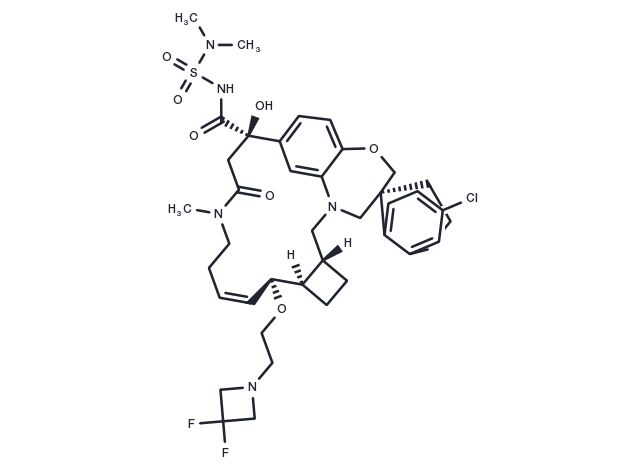Powder: -20°C for 3 years | In solvent: -80°C for 1 year


Mcl-1 inhibitor 3 shows good pharmacokinetic properties and excellent in vivo efficacy without toxicity.Mcl-1 inhibitor 3 is a highly potent and orally activate macrocyclic Mcl-1 inhibitor (Ki= 0.061 nM; IC50=19 nM in an OPM-2 cell viability assay).

| Pack Size | Availability | Price/USD | Quantity |
|---|---|---|---|
| 25 mg | Inquiry | $ 1,520.00 |
| Description | Mcl-1 inhibitor 3 shows good pharmacokinetic properties and excellent in vivo efficacy without toxicity.Mcl-1 inhibitor 3 is a highly potent and orally activate macrocyclic Mcl-1 inhibitor (Ki= 0.061 nM; IC50=19 nM in an OPM-2 cell viability assay). |
| Targets&IC50 | MCL1:0.061 nM (ki), MCL1:19 nM |
| In vitro | Mcl-1 inhibitor 3 shows an IC50 value of 19 nM in an OPM-2 cell viability assay, and a Ki value of 0.061 nM in Mcl-1 HTRF/TR-FRET assay. |
| In vivo | Mcl-1 inhibitor 3 (oral administration; 10, 30, or 60 mg/kg; 30 days) led to a robust dose-dependent tumor growth inhibition at 30 mg/kg (44% TGI) and 34% tumor regression when the animals were dosed at 60 mg/kg.Lastly, no body weight loss is observed in any of the mice in this study efficacy models.Mcl-1 inhibitor 3 (oral administration;?3, 10, or 30 mg/kg;?6 hours) causes a significant loss of luminescence (~40%) over vehicle at 30 mg/kg,This effect was observed with unbound drug levels in plasma, the [plasma]u/OPM-2 IC50 values are 0.24, 0.93 and 3.65 μM in 3, 10, 30 mg/kg doses,respectively.?Mcl-1 inhibitor 3 (oral administration;?10, 30, or 60 mg/kg;?6 hours) activates Bak by 8-fold at 30 mg/kg and by 14-fold at 60 mg/kg in this OPM-2 Luc assay,this test is based on the detection of activated Bak in nude mice subcutaneously injected with via electrochemiluminescence. |
| Molecular Weight | 820.39 |
| Formula | C40H52ClF2N5O7S |
| CAS No. | 2376774-73-9 |
Powder: -20°C for 3 years | In solvent: -80°C for 1 year
You can also refer to dose conversion for different animals. More
bottom
Please see Inhibitor Handling Instructions for more frequently ask questions. Topics include: how to prepare stock solutions, how to store products, and cautions on cell-based assays & animal experiments, etc.
Mcl-1 inhibitor 3 2376774-73-9 Apoptosis BCL Mcl 1 inhibitor 3 Mcl1 inhibitor 3 inhibitor inhibit
